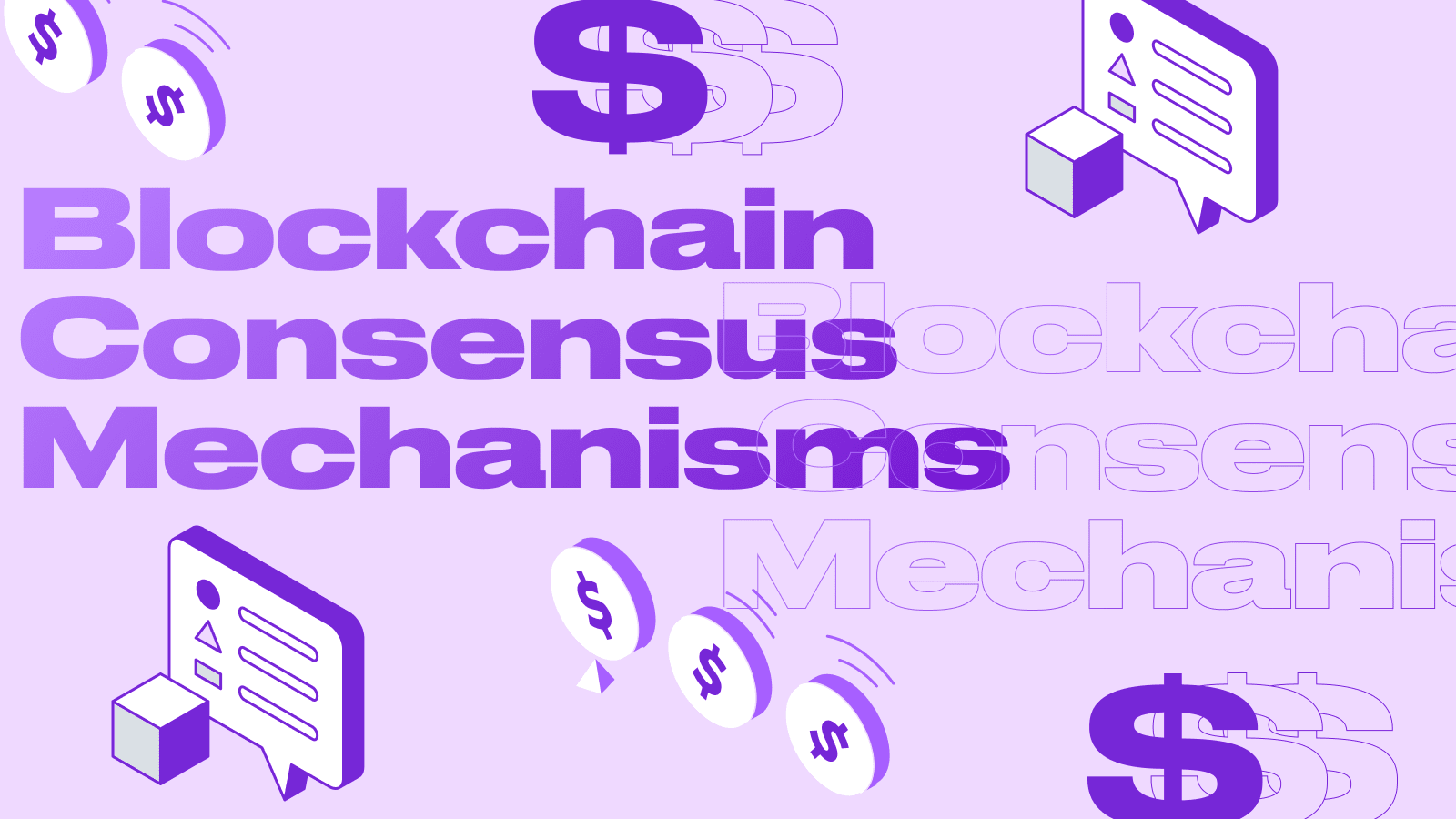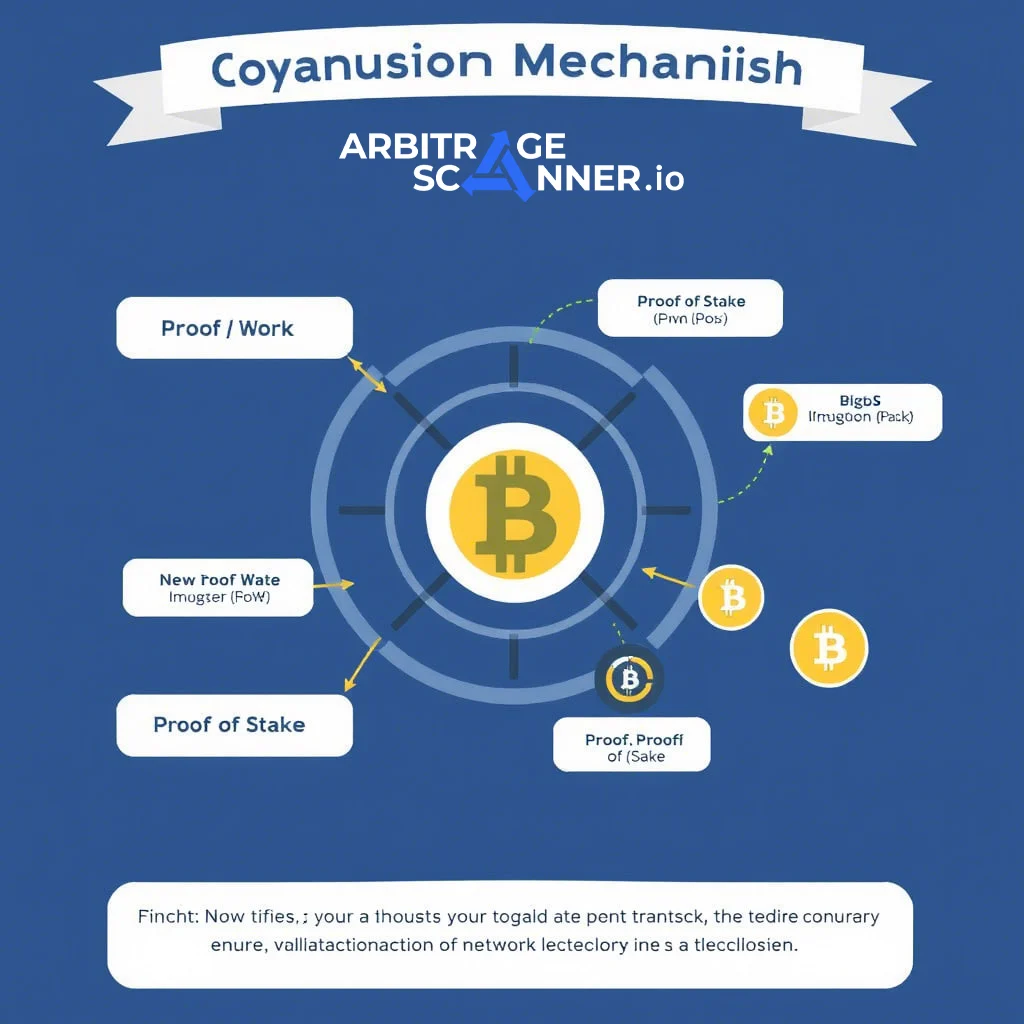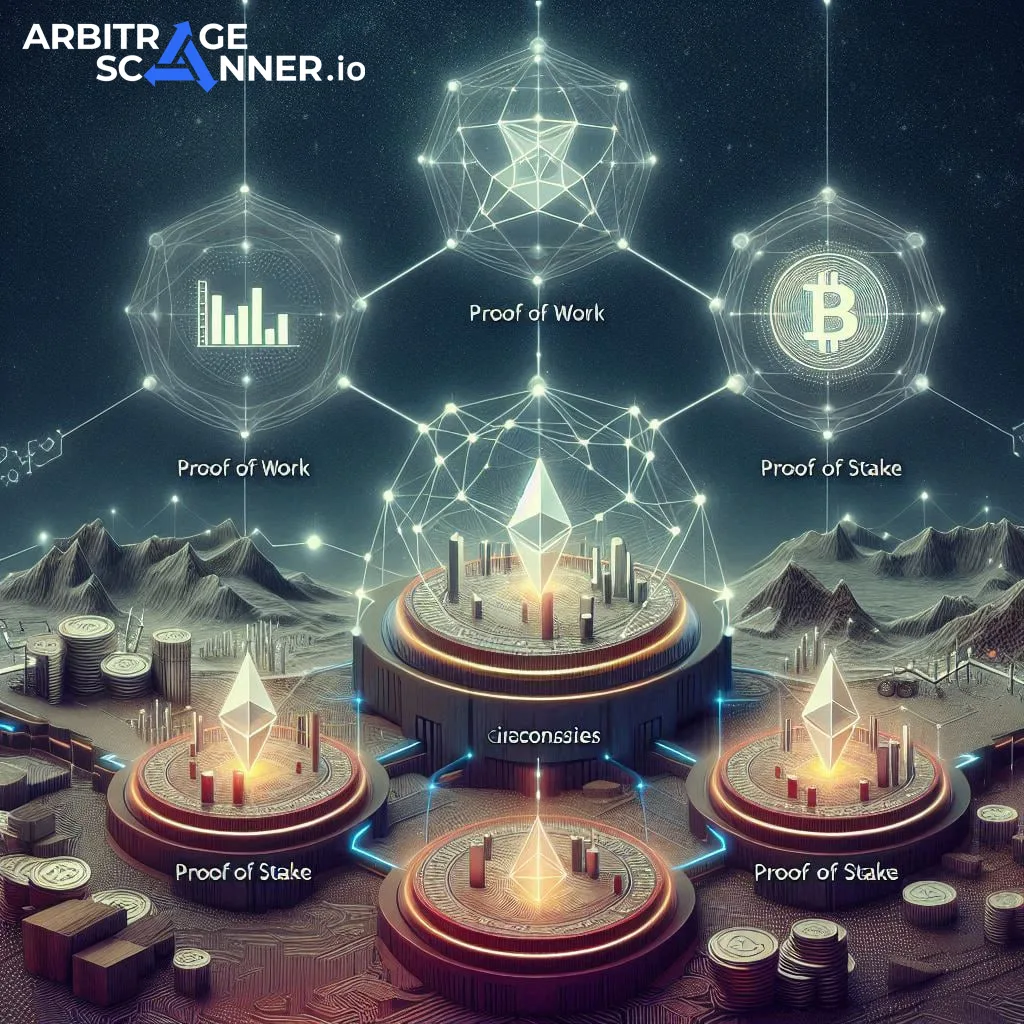Blockchain Consensus Mechanisms: Complete Guide 2025

Consensus Mechanisms in Blockchain: The Complete Guide 2025
Consensus mechanisms are a key element of any blockchain. It helps participants agree on any issue: adding new data, confirming transactions, and updating the network, while ensuring their security, trustworthiness, and immutability.
The first consensus mechanism was PoW, on which the bitcoin blockchain functions. By 2025, many other mechanisms have been created that solve the problems of scalability and decentralization. In this article, we will detail the existing consensus mechanisms and how they work.

The main types of consensus
Proof of Work (PoW)
As mentioned above, the first consensus mechanism that laid the groundwork for blockchain networks. Proof of work refers to the fact that complex, mathematical calculations will need to be performed to keep the blockchain running. These “instances” are solved using computing power: ASIC miners, GPUs, and video cards.
The PoW mechanism is characterized by a high level of security. All the devices that do the computation are not concentrated in one place. It can be done both by companies and ordinary people all over the world. In case one device somewhere stops functioning, the blockchain will be supported by others. The only thing that may change is the size of the transaction confirmation fee.
However, this consensus mechanism has its downside:
-
Energy costs. The devices consume simply huge amounts of electricity. Most of the earnings from mining will go to pay the bills;
-
Due to the fact that network expansion can only occur with new devices, the PoW algorithm does not scale well. New ASIC miners cannot appear all the time. Because of this, PoW blockchains experience higher fees when market volatility is high.
Proof of Stake (PoS, Proof of Stake)
The next most popular consensus algorithm is PoS. There is no mining here, but there is staking - a way to mine coins in this consensus algorithm, and here's how it works: a blockchain user must have a sufficient number of network coins in his account, in which case he can become a validator of the network. The validator blocks his coins to keep the network running, and begins to verify and validate transactions, as well as being responsible for adding new blocks, for which he is rewarded in network coins. The amount of rewards you receive depends on the coins you initially froze: the more you freeze, the more you get.
Advantages:
-
Scalability. Anyone can become a blockchain validator by simply buying its coins into a wallet and then freezing them afterward;
-
Energy efficiency. PoS will run all on one PC, which does not consume a lot of energy.
The most important disadvantage of PoS algorithms is the possibility of excessive centralization, especially in small networks. An investor with a large capital may well become the largest validator in the network of a project with a small capitalization. If this happens, the validator will gain control over transaction validation. For example, he can undo his own transactions (double spending) by sending funds to one address and then creating an alternate blockchain where those funds were not sent.
Key differences between PoS and PoW
-
Power consumption. The PoW algorithm requires a lot of power to maintain, and you need to take care of heat dissipation because the devices work around the clock. PoS has no such problem: only one PC can work;
-
Security. PoW wins here, because in the PoS consensus mechanism it is much easier to get control over the blockchain;
-
Scalability. PoS scales better due to lower time delays and is available to anyone who wants to buy the right coins.
Trade-offs
The choice between PoW and PoS depends on the goals of the project: PoW is suitable for decentralized and secure networks, while PoS is better suited for enterprise blockchains.
However, there are many examples of PoS mechanisms on the market, and the most famous of them is Ethereum. Yes, the project's blockchain was switched from PoW to PoS only in 2022, but enough time has passed and the Ethereum network continues to function properly.

Authority-based models
Proof of Authority
An interesting mechanism that allows new validators to be added only after existing validators are approved. In addition, approval only occurs after the challenger validates their identity. That said, the first validators of the network were chosen by the developers of the network. Validators are rewarded with cryptocurrency for adding new blocks.
The advantages of PoA are the same as those of the PoS algorithm. But there is one significant disadvantage - it is the addition of new validators only after the agreement of the old ones. Among them there may be “peculiar people” who will not agree to add normal validators, but, for example, may add their acquaintances, which may cause problems later on.
Delegated Proof of Stake
The consensus mechanism implies that large token holders can delegate their right to be the validator of the network to other, trusted participants in the network - delegates. Delegates may also be called witnesses, and they are responsible for building consensus during the process of creating and validating new blocks.
Minus - large token holders (whales) have more influence over the selection of delegates, which can lead to the formation of an “elite group” of validators.
Examples of use cases
-
PoA: Used in enterprise blockchains such as VeChain;
-
DPoS: Used in EOS and TRON projects.
Alternative consensus methods
Byzantine Fault Tolerance (BTC)
The principle of the BTC mechanism is that it is deployed in a network with a known number of validators: there cannot be more than a predetermined number of validators. It also requires a certain number of validators to check each transaction. Examples: Tendermint, Hyperledger Fabric.
Proof of Burn.
A very experimental mechanism: to become a validator in a PoB network, you need to “burn” a certain number of tokens, i.e. send them to an unused address where they will not be accessed. The more tokens burned, the more likely it is to become a network validator. This approach proves the aspirant's desire to take the place of a validator before other participants in the network. Examples: Counterparty, Slimcoin.
Proof of Capacity
PoC relies on the available storage space of network participants to validate blocks and create new ones. The mechanism has not been widely spread among cryptocurrencies: the first project with PoC Burstcoin was created back in 2014, and since then there have been no more than 5 more projects with the same consensus algorithm.
Proof of Elapsed Time
The algorithm generates a random elapsed time for each node in the blockchain network, and each node must sleep during this time. The node with the shortest wait time wakes up first and gets to add a new block to the blockchain and get rewarded. Example: Hyperledger Sawtooth.
New consensus mechanisms
Proof of Activity
This mechanism combines the two - PoW and PoS. Its essence is as follows: PoW blocks are generated together with PoS blocks, i.e. the blockchain consists of both types of blocks. PoW miners do the work first, then the block is finalized by PoS holders. The purpose of the algorithm is to increase the level of protection against potential attacks, such as 51% attack or Denial-of-Service (DoS). Examples include YaCoin, NovaCoin, EmerCoin.
Proof of Weight
The mechanism has a very interesting implementation: the more coins a network member has on his wallet, the more his “weight” is, which means he is more worthy of adding a block to the chain. Needless to say, the PoW mechanism is not very popular in the crypto industry, because of the high entry threshold for new miners. Example: Algorand.
Proof of Importance.
In a PoI mechanism, a network member must prove its importance: it is not so important how many coins are frozen, but more important is the network activity of the member. The validator must have a good reputation (determined by a separate special system), a large number of incoming and outgoing transactions, and a decent number of unfrozen coins. This is how the network determines the most useful network and allows it to add a new block. Example: NEM.
Leased Proof of Stake.
This algorithm is similar to pools that pool funds for staking or mining, to increase the chances of being rewarded. Only in the case of LPoS, there is no need to look into pools - this mechanism is built into the consensus: small holders of coins can rent them to large nodes. Interestingly, rented coins increase the “weight” of a node, making it more likely to add a new block to the chain. Leased coins remain in the possession of the owner and can be withdrawn at any time. Example: Waves.
Technical comparison

Energy efficiency
PoW and PoS mechanisms have already been mentioned, but if we compare them to a couple of other mechanisms:
-
PoC: utilizes available storage space, making it more energy efficient than PoW;
-
PoET: minimizes energy consumption by setting random wait times for validators.
Scalability
-
PoW scales poorly due to limitations on the speed of adding new devices and high latency;
-
PoS is more flexible: anyone with enough coins can become a validator;
-
DPoS exhibits high throughput due to the limited number of delegates.
Security aspects
-
PoW provides a high level of security by decentralizing computing power. However, a 51% attack is possible when significant resources are concentrated;
-
PoS is vulnerable to centralization risks, especially in small networks where large investors may control a large part of the network;
-
PoA is vulnerable due to human error: the choice of validators may depend on a subjective decision.
Levels of decentralization
-
PoW: high decentralization, as devices are distributed worldwide;
-
PoS: possible centralization if large coin holders have a dominant position;
-
DPoS: there is a risk of forming an “elite group” of validators.
Implementation Analysis
Network requirements
Proof of Work (PoW)
-
Hardware: Participating in a PoW network requires powerful computing devices such as ASICs or GPUs capable of performing complex mathematical calculations;
-
Power consumption: PoW networks are characterized by high power consumption, resulting in significant operational costs.
Proof of Stake (PoS)
-
Hardware: Participation in PoS networks requires a computer with basic characteristics, since the staking process does not depend on high computing power;
-
Staking: It is necessary to own a certain number of network tokens and freeze them in order to participate in the validation process.
Proof of Authority (PoA)
-
Validators: Requires a limited number of trusted nodes whose identity is verified and trusted by other participants in the network;
-
Infrastructure: Low hardware requirements since the validation process does not require significant computing resources.
Delegated Proof of Stake (DPoS)
-
Delegates: Reliable network participants must be selected to perform validation functions on behalf of other users;
-
Voting: Users must actively participate in the voting process to select delegates, which requires mechanisms to be in place on the network.
Practical considerations
Project goals
-
PoW is suitable for decentralized, secure networks (e.g. Bitcoin).
-
PoS and its variations are optimal for energy efficient and scalable solutions.
-
PoA is ideal for private and enterprise blockchains.
Financial costs
-
PoW requires significant hardware and power costs.
-
PoS, PoA, and their variations minimize operational costs.
Scalability and speed
-
PoS and DPoS provide fast transaction processing and high throughput.
Decentralization layer
-
PoW provides maximum decentralization.
-
PoS and PoA can be more centralized but easier to manage.
Technical complexity
-
PoW requires infrastructure for mining.
-
PoS and other mechanisms are easier to deploy.
Example of choice
-
Ethereum moved to PoS for energy efficiency and scalability.
-
Hyperledger Fabric uses BFT for security in enterprise networks.
Future Consensus Mechanisms: Innovations and Prospects
The world of blockchain technology continues to experiment with new consensus mechanisms that seek to solve current network problems and meet the growing needs of users. Hybrid models and algorithms such as Proof of Importance and Proof of Elapsed Time offer the prospect of more efficient, resilient and secure blockchains. In the future, we can expect even more innovative approaches that will change the face of the industry.
Conclusion
Consensus mechanisms continue to evolve, offering different approaches to make blockchains secure, decentralized, and scalable. The choice depends on a project's goals, audience, and financial capabilities.
Today, the PoS consensus mechanism dominates the market more, because it offers more opportunities for further scaling, and transactions in these networks are much faster when compared to PoW. In the coming years, we can expect to see new hybrid mechanisms that combine the best aspects of existing models.
Frequently Asked Questions (FAQ)
Which consensus mechanism is the most energy efficient?
PoS and PoET are the most energy efficient.
How do different consensus methods affect network security?
PoW provides maximum protection against 51% attacks, while PoS and DPoS are more vulnerable due to the risk of centralization.
What are the implications for scalability of each mechanism?
PoS and DPoS outperform PoW in terms of transaction processing speed and ability to scale.
Which type of consensus is best suited for enterprise blockchains?
PoA, due to its control over the choice of validators.
How does the level of decentralization vary between consensus methods?
PoW is the most decentralized, while PoS and DPoS may face the risk of centralization due to the influence of large participants.
Want to learn more about crypto arbitrage?
Get a subscription and access the best tool on the market for arbitrage on Spot, Futures, CEX, and DEX exchanges.




